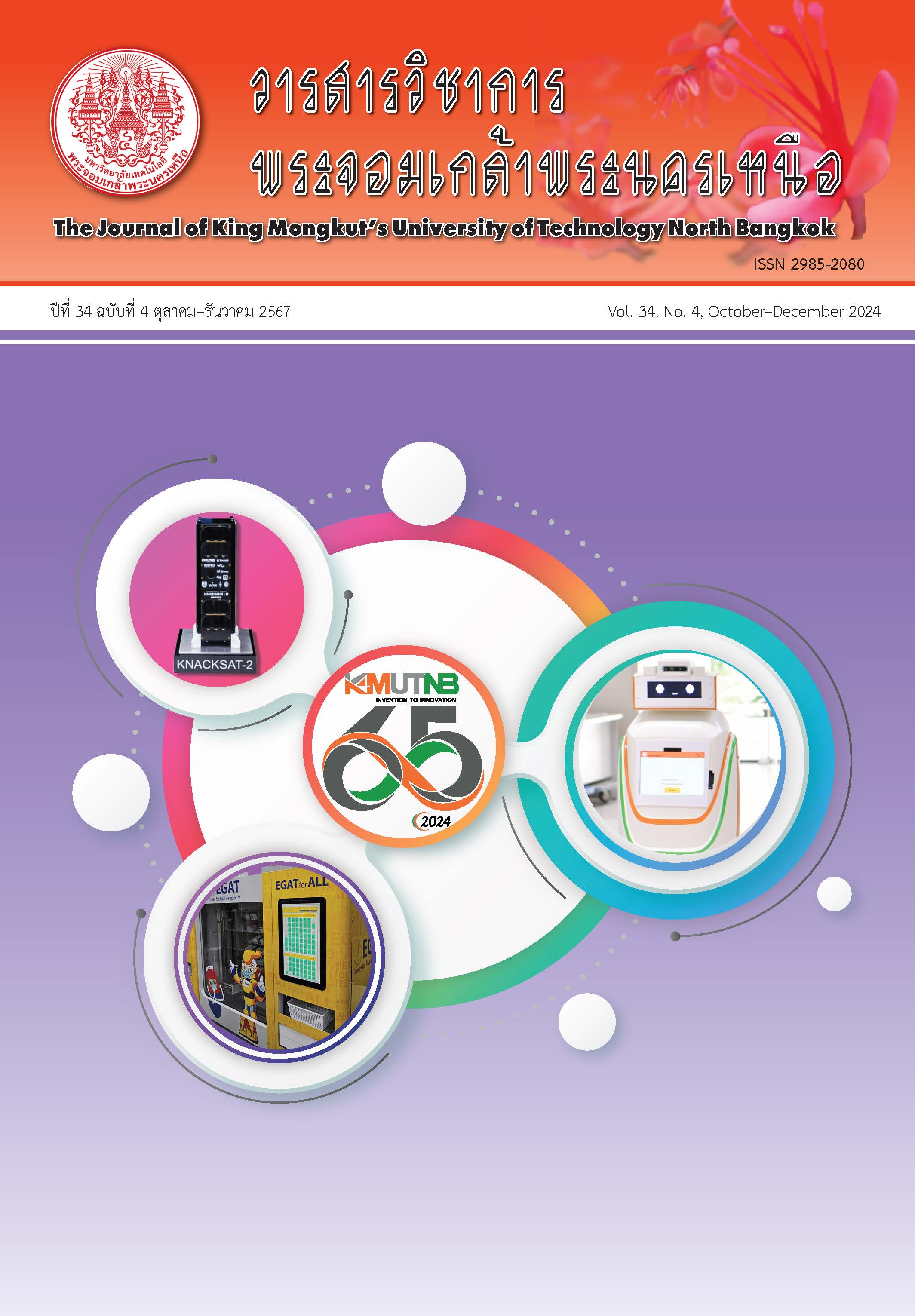A Hybrid ARIMA and Artificial Neural Networks Model Using L-BFGS-B Method for Forecasting the Annual Chicken Meat Production
Main Article Content
Abstract
Livestock products play an important role in food security management. One of the livestock products is chicken meat, which is a source of protein and popular staple food for human all over the world. Moreover, the demand of chicken meat tends to increase due to population increment. For food security management, one of the most important information is production of supply side in order to provide available and sufficient production for people. However, the production of chicken meat is fluctuating and uncertain in each year due to uncontrolled effects. Consequently, forecasting techniques play a crucial role for prediction in advance. In this research, a hybridization of ARIMA, Feed-forward neural network, and L-BFGS-B methods is developed and proposed to extrapolate production of chicken meat in advance. Furthermore, the proposed model is compared to four forecasting models, which are ARIMA, Holt’s method, simple exponential smoothing, and support vector regression, respectively. The comparison is based on three accuracy measures that are mean absolute error, mean absolute percentage error, and symmetric mean absolute percentage error, respectively. The empirical results revealed that the proposed model outperforms other forecasting models. Moreover, the proposed model provides less than 10% of mean absolute percentage error, which indicates that the proposed model can provide more accuracy of forecasting. Therefore, the proposed model can be a promising tool for prediction of chicken meat productions in order to support decision making on food security management.
Article Details

This work is licensed under a Creative Commons Attribution-NonCommercial-NoDerivatives 4.0 International License.
The articles published are the opinion of the author only. The author is responsible for any legal consequences. That may arise from that article.
References
N. Daghir, M. Diab-El-Harake, and S. Kharroubi, “Poultry production and its effects on food security in the Middle Eastern and North African region,” Journal of Applied Poultry Research, vol. 30, no. 1, 2021.
E. M. Idamokoro and Y. S. Hosu, “Village chicken production and food security: A two-decade bibliometric analysis of global research trends,” Agriculture and Food Security, vol. 11, no. 1, pp. 1–20, 2022.
L. O. Pius, P. Strausz, and S. Kusza, “Overview of poultry management as a key factor for solving food and nutritional security with a special focus on chicken breeding in East African countries,” Biology, vol. 10, no. 8, 2021.
D. I. A. Hamzah, M. S. Rusiman, N. C. Him, M. A. Shafi, O. G. Alma, and S. Suhartono, “A time series analysis for sales of chicken based food product,” in AIP Conference Proceedings, 2021, pp. 060002.
V. Tenrisanna and S. N. Kasim, “Trends and forecasting of meat production and consumption in Indonesia: Livestock development strategies,” in IOP conference series: Earth and Environmental Science, 2020, vol. 492, no. 1, 2020.
J. F. Mgaya, “Application of ARIMA models in forecasting livestock products consumption in Tanzania,” Cogent Food & Agriculture, vol. 5, no.1, 2019.
Ö. Z. E. N. Doğukan, “Modeling and forecasting meat consumption per Capita in Turkey.” Erciyes Üniversitesi Veteriner Fakültesi Dergisi, vol. 16, no. 2, pp. 122–129, 2019.
A. Pujiati, S. Oktavilia, and N. Damayanti, “The Projection Model As an Early Warning of Food Price Commodity Fluctuation,” in International Conference on Economics, Business and Economic Education 2018 (ICE-BEES 2018), 2018, pp. 860–868.
M. M. Alderiny, K. N. Alrwis, S. B. Ahmed, and N. M. Aldawdahi, “Forecasting Saudi Arabia’s production and imports of broiler meat chickens and its effect on expected self-sufficiency ratio,” Journal of the Saudi Society of Agricultural Sciences, vol. 19, no. 4, pp. 306–312, 2020.
E. R. Abraham, J. G. M. dos Reis, O. Ven drametto, P. L. D. Oliveira Costa Neto, R. C. Toloi, A. E. D. Souza, and M. D. Oliveira Morais, “Time series prediction with Artificial Neural Networks: An analysis using Brazilian soybean production,” Agriculture, vol. 10, no. 10, pp. 475, 2020.
D. Zhang, S. Chen, L. Liwen, and Q. Xia, “Forecasting agricultural commodity prices using model selection framework with time series features and forecast horizons,” IEEE Access, vol. 8, pp. 28197–28209, 2020.
B. Madhu, M. A. Rahman, A. Mukherjee, M. Z. Islam, R. Roy, and L. E. Ali, “A comparative study of support vector machine and artificial neural network for option price prediction,” Journal of Computer and Communications, vol. 9, no. 5, pp.78–91, 2021.
Y. Tang, and C. Li, “The study on livestock production prediction in heilongjiang province based on support vector machine,” in Conference of the 2nd International Conference on Computer Science and Electronics Engineering (ICCSEE 2013), 2013, pp. 1192–1195.
K. Naveena, S. Singh, S. Rathod, and A. Singh, “Hybrid ARIMA-ANN modelling for forecasting the price of robusta coffee in India,” I n t e r n a t i o n a l J o u r n a l o f C u r r e n t Microbiology and Applied Sciences, vol. 6, no. 7, pp. 1721–1726, 2017.
R. Mrinmoy, R. S. Tomar, V. Ramasubramanian, and K. N. Singh, “Forecasting sugarcane yield of India using ARIMA-ANN hybrid model,” Bhartiya Krishi Anusandhan Patrika, vol.33, no. 1/2, pp.120–127, 2018.
Z. Liu, Z. Zhu, J. Gao, and C. Xu, “Forecast methods for time series data: A survey,” IEEE Access, vol. 9, pp. 91896–91912, 2021.
R. Hyndman, G. Athanasopoulos, C. Berg meir, G. Caceres, L. Chhay, K. Kuroptev, M. O'Hara-Wild, F. Petropoulos, S. Razbash, E. Wang, F. Yasmeen, D. Reid, D. Shaub, F. Garza, R. Core Team, R. Ihaka, X. Wang, Y. Tang, and Z. Zhou. (2022, October). Forecast: Forecasting functions for time series and linear models. [Online]. Available: https://cran.r-project.org/ web/packages/forecast/index.html
T. Sujjaviriyasup, “Hybrid model of support vector machine and genetic algorithm for forecasting the annual peak electricity demand of Thailand,” The Journal of KMUTNB, vol. 27, no. 3, pp. 453–465, 2017 (in Thai).
C. Bergmeir, R. J. Hyndman, and B. Koo, “A note on the validity of cross-validation for evaluating autoregressive time series prediction,” Computational Statistics & Data Analysis, vol. 120, pp. 70–83, 2018.

